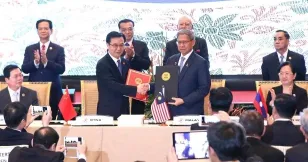从日本普惠制 “毕业”,中马泰如何“天天向上”
□ 文/本刊记者 陈丽冰
从日本普惠制 “毕业”,中马泰如何“天天向上”
□ 文/本刊记者 陈丽冰

日本本田在泰国的分工厂
据《日本经济新闻》报道,2016年11月24日,日本财务省正式宣布重新调整“特惠关税”制度的对象国,按照新标准将中国、泰国、马来西亚、墨西哥、巴西5个国家从发展中国家关税减免名单中剔除。这是继2014年从欧盟普惠制“毕业”后,又一个普惠制给惠国把中国、马来西亚、泰国剔除出受惠国行列。
作为“10+6”主要成员国之一,近年来日本与中国、东盟的经贸合作日益密切。在此背景下,日本普惠制红利的消失将给中国、马来西亚、泰国带来哪些影响?相关企业又将如何未雨绸缪才能规避“毕业”机制所带来的影响?

中国—东盟自贸区升级版于2015年11月22日完成谈判,目前,自贸区内90%以上种类的产品实现了零关税
“毕业”后带来的影响
普惠制是工业发达国家对发展中国家或地区出口的制成品和半制成品给予普遍的、非歧视的、非互惠的关税制度,当受惠国产品在国际市场上显示较强竞争力时,其优惠资格取消,即所谓的“毕业”。
据了解,在日本2015年度适用优惠税率的进口产品当中,约60%来自中国。不过,日本“特惠关税”一旦取消,约2000多个HS编码(也称海关编码)的中国产品进入日本将被重新征收3%以上的关税,这必将增加出口企业关税成本,缩小利润空间。
在这方面,泰国、马来西亚同样也将面临此类问题。据泰国商业部国际贸易厅透露,日本调整对发展中国家取消提供普遍优惠制条件的政策后,将导致泰国14项商品在2019年4月1日被日本撤销普惠制优惠待遇。而根据2016年11月30日数据显示,该14项商品的贸易价值约1579万美元。在14项商品中,约有6项商品将因为被撤销特惠关税而受影响,分别为山梨糖醇、无咖啡因咖啡、没有转变形态的乙醇、木合板、木层压板及木块芯板。
另外,由于日本在取消对中马泰等国家普惠制待遇的同时,却保留越南、印尼、柬埔寨等国家的普惠制待遇。在此背景下,不管是对于中国,还是泰国、马来西亚的外贸企业来说,随着普惠制的取消,将会削减部分输日产品的竞争力,及改变中国、泰国及马来西亚等国家本土外贸企业或是日资企业的投资方向。
“对于具体出口行业和企业而言,可能会在短期形成一定冲击。由于不再给予优惠关税,一些对出口价格比较敏感的低值类日用品、轻工产品可能会转向东南亚,如越南、印尼等仍然可以享受特惠关税的国家。”中国商务部研究院国际服务贸易研究所研究员、副所长李俊在接受本刊记者采访时表示。
“毕业”企业何去何从
日本“特惠关税”红利的消失,相关“毕业”的出口企业确实会受到或多或少的影响。不过目前看来,中马泰从日本普惠制“毕业”已是一个不可避免的趋势。在此情形下,业内专家分析认为,相关企业要早做准备,采用市场多元化策略,才能避免因政策调整造成的利益受损、客户流失。
对此,李俊认为,相关企业一方面可以提高出口产品的品质、品牌,走以质取胜的道路,通过培育境外消费者的品牌忠实度,让其对出口产品的价格不再敏感,而是更多关注产品的品质和品牌。这样,即使多征收一些关税,也不会影响相关产品的国外销售。另外,则可以适度开展国际化生产布局,利用部分东盟国家仍然享受日本特惠关税的优势,尝试开展国际化生产,如利用越南、印尼等原产地开展对日出口。同时,在国内主要发展品牌运营、财务结算、研发设计等高端功能,将有利于中马泰三国在全球价值链的分工中优化升级。
除此之外,还应当看到,近年来随着东盟共同体和中国—东盟自贸区升级版的成立,包括东盟在内的新兴经济体的消费市场增长速度更快、潜力更大。因此,中马泰国家的相关企业除了可以“曲线”利用普惠制原产地规则,到越南、印尼、柬埔寨等东盟国家投资建厂外,还应把更多的目光转回拥有19亿人口,且诸多产品优势互补的中国—东盟市场,以更好地“抱团取暖”。
“企业要继续保持在发达国家出口优势的同时,也要把市场开拓的重点逐步转移到新兴经济体,尤其是与中国签署自由贸易协定(FTA),享受协定优惠税率的经济体。目前,中国—东盟自贸区升级版建设为中国企业开拓东盟市场提供了机遇,90%以上产品实现了零关税,因此,企业要充分利用FTA提供的政策优势,开拓对这些国家的出口市场,弥补发达国家经济衰退,贸易市场低迷以及特惠关税政策取消带来的市场缺口。”李俊如是说道。
从长远发展来看,如今日本宣布对包括中国、泰国、马来西亚等国家取消“特惠关税”,只不过是让相关企业较早地失去了“保护伞”。但从另一个层面来看,这其实也是在为即将“毕业”的企业酝酿一个离开温室,到外面世界吸取更多阳光的机遇。因此,不管是更新换代产品,提高企业的国际竞争力,还是“曲线”利用第三国的成本优势和优惠待遇,亦或是转变销售市场方向,在距离普惠制红利正式消失还有两年的时间里,相关企业还应提前未雨绸缪,才能将负面影响降到最低。
·联系编辑:78724815@qq.com
I nformation and communications technology (ICT) now appears to be as crucial for economic growth as transportation and energy infrastructure. Footloose entrepreneurs and Internetsavvy consumers are using small-scale mobile applications to create virtual markets and circumvent regulations. At the same time, developing countries are using ICT to leap-frog traditional growth stages in boosting market connectivity and industrial productivity. ICT proliferation has even been interpreted as a binding force, with international connections among cities and industrial regions having a pacifying effect on geopolitics. Developing countries in ASEAN have already targeted the productivity boost of urbanization and globalization, and ICT is the next frontier. However, there are significant disparities in broadband reliability and penetration across ASEAN. Efforts to create a structurally cohesive and globally competitive bloc, as embodied by the new ASEAN Economic Community, can be enhanced by regional collaboration in ICT and broadband infrastructure development.
ICT in Asia: Mixed performance
In the Asia-Pacific region 41.9 percent of the population uses the Internet, roughly half the percentage in Europe and 23 percentage points behind the Americas. Further, the region’s fixed broadband penetration is only one third that of Europe, with a majority accounted for by East and Northeast Asia (74 percent). Unsurprisingly, China far outpaces all Asian countries in fixed broadband penetration, expanding from a minimal level in 2002 to over 40 million subscriptions by 2015. Only Japan achieved comparable growth over the same period, but growth has flattened in recent years and subscription rates are still only one sixth of China’s.
In ASEAN countries, mobile connectivity is rapidly increasing but large gaps in Internet penetrationpersist. Cambodia, Vietnam, and Thailand have ASEAN’s highest number of mobile Internet connections as a percentage of national population, and eight of ASEAN’s ten countries exceed the global average. However, ASEAN still lags East and Northeast Asia in broadband penetration, evident from recent data published by the United Nations Economic and Social Commission for Asia and the Pacific (ESCAP). In fixed broadband subscriptions per 1,000 inhabitants, Singapore leads ASEAN at 26.5 but lags South Korea’s 40.2. Thailand and Malaysia hold distant second and third place in the region (9.2 and 9.0, respectively), followed by Vietnam (8.1) and Brunei (8.0). ASEAN’s laggards are Myanmar (0.3), Laos and Cambodia (0.5), Indonesia (1.1), and the Philippines (3.4). The latter occupy the Asia-Pacific region’s bottom half for the same measure. However, there is some sign of progress. Brunei, Malaysia, and Thailand made notable improvements in fixed broadband penetration between 2005 and 2015. Other measures are less promising. Between 2008 and 2014, the Philippines, Thailand, Vietnam, and Cambodia regressed in government online service scores despite improving telecommunications infrastructure. This illustrates the well-worn adage that technology is only as good as its application; investment is wasted without an understanding of how hardware helps achieve meaningful outcomes.
Improved broadband infrastructure would enable ASEAN countries to embrace more leading-edge technologies and related innovations in application. Uptake for the Internet of Things, an emerging application through which objects communicate with one another, is measured often through number of mobile-to-mobile (M2M) subscriptions per standard mobile subscription. By this metric, the greatest gains have been in advanced economies, with Sweden achieving more than twice the uptake as second-place New Zealand. Among Asian countries, only South Korea (18th) ranks among the top-20. This is surprising given South Korea’s highly advanced ICT infrastructure; it is the only country where 100 percent of fixed broadband connections have a speed at or above 10 megabits per second. Asian countries must not fall any further behind on M2M technologies. While Northeast Asia has the technological capacity to catch up quickly, ASEAN will not be globally competitive in leading-edge technologies such as the“Internet of Things” without improving broadband connectivity.
Towards a regional solution
The independent pursuit of broadband development within countries has resulted in sizable regional differences in connection speeds. To most people who rely on the Internet for at least part of their work, the link between Internet speed and productivity is clear. Internet speeds in South Korea, Japan, and Hong Kong are among the top-10 fastest in the world, but ASEAN and China are lagging. As mobile applications become more sophisticated, the potential for business development and scaling of entrepreneurial activities is growing. Providing basic infrastructure for broadband connectivity — and normalizing speeds across countries —is an urgent regional policy imperative. Incorporating such an infrastructure initiative into the collaborative apparatus that already exists for ASEAN is a viable strategy to close the connectivity gap between ASEAN and high-performing countries in Asia, Europe, and North America.
TheASEAN ICT Masterplan 2020proposes three initiatives: improve access and connectivity, manage disaster threats, and promote cloud computing. While the plan aims to reduce disparities and improve interoperability, there is no explicit commitment to establish region-wide standards or targets for broadband speed, penetration, and reliability. ASEAN has an opportunity to be the world’s first ICT bloc, boasting tight strategic coordination, common standards for performance, and a funding facility for infrastructure within and across borders. The national-scale institutional elements of ICT (regulation, management, education, etc.) are receiving due attention from domestic policymakers, but elevating regional broadband capacity to global standard— an essential catalyst for industrial transformation — is fundamentally about hard infrastructure.
The way forward is challenging. Development of a regional broadband infrastructure platform would require thorough accounting of the bottlenecks typically attending major public works projects; these include not only financing and geography but also local and national politics. Improving infrastructure through regional initiative also introduces the specter of institutional and administrative complexity. For example, the regional rail corridor proposed for Southeast Asia is dependent on the participation of all contiguous nations— there is little collective benefit if one precocious nation completes its segment while other nations are mired in political and administrative gridlock. The dynamic is similar for ICT, and urgency for efficient collaboration is growing with upcoming investments in additional submarine cable systems. Broadband infrastructure must be developed and managed as a regional resource, lest cross-country performance gaps widen. In the collective spirit of the recently implemented ASEAN Economic Community, institutions and infrastructure underpinning economic growth are “everybody’s business.” Even ASEAN’s most successful economies will not achieve their potential without well-connected and competitive neighbors
· Source: www.thediplomat.com
ASEAN’s Broadband Infrastructure Imperative
By Kris Hartley

